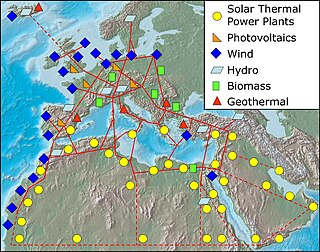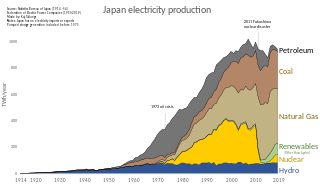
Electricity generation is the process of generating electric power from sources of primary energy. For utilities in the electric power industry, it is the stage prior to its delivery to end users or its storage, using for example, the pumped-storage method.

Energy development is the field of activities focused on obtaining sources of energy from natural resources. These activities include the production of renewable, nuclear, and fossil fuel derived sources of energy, and for the recovery and reuse of energy that would otherwise be wasted. Energy conservation and efficiency measures reduce the demand for energy development, and can have benefits to society with improvements to environmental issues.

The State Grid Corporation of China (SGCC), commonly known as the State Grid, is a Chinese state-owned electric utility corporation. It is the largest utility company in the world. As of March 2024, State Grid is the world's third largest company overall by revenue, behind Walmart and Amazon. In 2023 it was reported as having 1.3 million employees, 1.1 billion customers and revenue equivalent to US$546 billion. It is overseen by the State-owned Assets Supervision and Administration Commission of the State Council.

Nuclear energy policy is a national and international policy concerning some or all aspects of nuclear energy and the nuclear fuel cycle, such as uranium mining, ore concentration, conversion, enrichment for nuclear fuel, generating electricity by nuclear power, storing and reprocessing spent nuclear fuel, and disposal of radioactive waste. Nuclear energy policies often include the regulation of energy use and standards relating to the nuclear fuel cycle. Other measures include efficiency standards, safety regulations, emission standards, fiscal policies, and legislation on energy trading, transport of nuclear waste and contaminated materials, and their storage. Governments might subsidize nuclear energy and arrange international treaties and trade agreements about the import and export of nuclear technology, electricity, nuclear waste, and uranium.

Japan is a major consumer of energy, ranking fifth in the world by primary energy use. Fossil fuels accounted for 88% of Japan's primary energy in 2019. Japan imports most of its energy due to scarce domestic resources. As of 2022, the country imports 97% of its oil and is the largest liquefied natural gas (LNG) importer globally.

The energy policy of the United States is determined by federal, state, and local entities. It addresses issues of energy production, distribution, consumption, and modes of use, such as building codes, mileage standards, and commuting policies. Energy policy may be addressed via legislation, regulation, court decisions, public participation, and other techniques.
Energy planning has a number of different meanings, but the most common meaning of the term is the process of developing long-range policies to help guide the future of a local, national, regional or even the global energy system. Energy planning is often conducted within governmental organizations but may also be carried out by large energy companies such as electric utilities or oil and gas producers. These oil and gas producers release greenhouse gas emissions. Energy planning may be carried out with input from different stakeholders drawn from government agencies, local utilities, academia and other interest groups.
Nuclear power is a major power source in South Korea, providing 30% of the country's electricity. The total electrical generation capacity of the nuclear power plants of South Korea is 20.5 GWe from 23 reactors, equivalent to 22% of South Korea's total electrical generation capacity.
For solar power, South Asia has the ideal combination of both high solar insolation and a high density of potential customers.

China is the world's leader in electricity production from renewable energy sources, with over triple the generation of the second-ranking country, the United States. China's renewable energy sector is growing faster than its fossil fuels and nuclear power capacity, and is expected to contribute 43% of global renewable capacity growth. China's total renewable energy capacity exceeded 1,000 GW in 2021, accounting for 43.5 per cent of the country's total power generation capacity, 10.2 percentage points higher than in 2015. The country aims to have 80 per cent of its total energy mix come from non-fossil fuel sources by 2060, and achieve a combined 1,200 GW of solar and wind capacity by 2030. In 2023, it was reported that China was on track to reach 1,371 gigawatts of wind and solar by 2025, five years ahead of target due to new renewables installations breaking records. In 2024, it was reported that China would reach its target by the end of July 2024, six years ahead of target.

Solar power, also known as solar electricity, is the conversion of energy from sunlight into electricity, either directly using photovoltaics (PV) or indirectly using concentrated solar power. Solar panels use the photovoltaic effect to convert light into an electric current. Concentrated solar power systems use lenses or mirrors and solar tracking systems to focus a large area of sunlight to a hot spot, often to drive a steam turbine.
DESERTEC is a non-profit foundation that focuses on the production of renewable energy in desert regions. The project aims to create a global renewable energy plan based on the concept of harnessing sustainable powers, from sites where renewable sources of energy are more abundant, and transferring it through high-voltage direct current transmission to consumption centers. The foundation also works on concepts involving green hydrogen. Multiple types of renewable energy sources are envisioned, but their plan is centered around the natural climate of the deserts.

China is the world's largest electricity producer, having overtaken the United States in 2011 after rapid growth since the early 1990s. In 2021, China produced 8.5 petawatt-hour (PWh) of electricity, approximately 30% of the world's electricity production.

An electrical grid is an interconnected network for electricity delivery from producers to consumers. Electrical grids consist of power stations, electrical substations to step voltage up or down, electric power transmission to carry power over long distances, and finally electric power distribution to customers. In that last step, voltage is stepped down again to the required service voltage. Power stations are typically built close to energy sources and far from densely populated areas. Electrical grids vary in size and can cover whole countries or continents. From small to large there are microgrids, wide area synchronous grids, and super grids. The combined transmission and distribution network is part of electricity delivery, known as the power grid.

A super grid or supergrid is a wide-area transmission network, generally trans-continental or multinational, that is intended to make possible the trade of high volumes of electricity across great distances. It is sometimes also referred to as a "mega grid". Super grids typically are proposed to use high-voltage direct current (HVDC) to transmit electricity long distances. The latest generation of HVDC power lines can transmit energy with losses of only 1.6% per 1,000 km.

The utility electricity sector in Bangladesh has one national grid operated by Power Grid Company of Bangladesh with an installed capacity of 25,700 MW as of June 2022. Bangladesh's energy sector is not up to the mark. However, per capita energy consumption in Bangladesh is considered higher than the production. Electricity was introduced to the country on 7 December 1901.

Energy in Uruguay describes energy and electricity production, consumption and import in Uruguay. As part of climate mitigation measures and an energy transformation, Uruguay has converted over 98% of its electrical grid to sustainable energy sources. Fossil fuels are primarily imported into Uruguay for transportation, industrial uses and applications like domestic cooking. Four hydroelectric dams provide much of the country's energy supply.

The Karuma Hydroelectric Power Station is an operational 600 MW hydroelectric power station in Uganda. It is the largest power-generating installation in the country.

The electric power industry in Japan covers the generation, transmission, distribution, and sale of electric energy in Japan. Japan consumed approximately 918 terawatt-hours (TWh) of electricity in 2014. Before the 2011 Fukushima Daiichi nuclear disaster, about a quarter of electricity in the country was generated by nuclear power. In the following years, most nuclear power plants have been on hold, being replaced mostly by coal and natural gas. Solar power is a growing source of electricity, and Japan has the third largest solar installed capacity with about 50 GW as of 2017. Japan's electricity production is characterized by a diverse energy mix, including nuclear, fossil fuels, renewable energy, and hydroelectric power.
One Nevada is a 235-mile (378 km), 500-kilovolt, 600-megawatt power line that runs from Southern to Northern Nevada. NV Energy owns 25% of the transmission line and operates and offers the line's capacity under the terms of NV Energy's Open Access Transmission Tariff. Great Basin Transmission South owns 75% of the line. The line runs from the new Robinson Summit Substation in Ely to Apex, connecting with the existing NV Energy Harry Allen Generating Station, and uses tubular guyed-V towers on a single point foundation.















